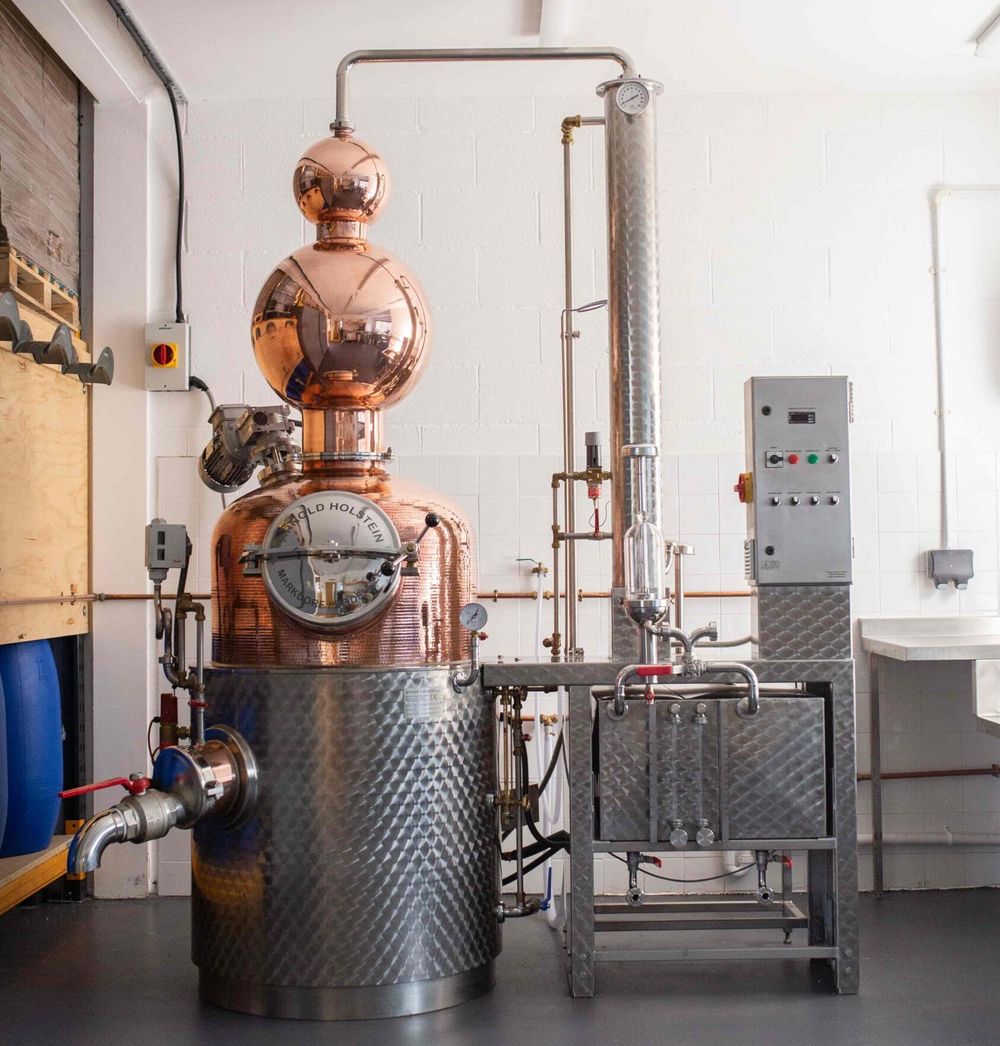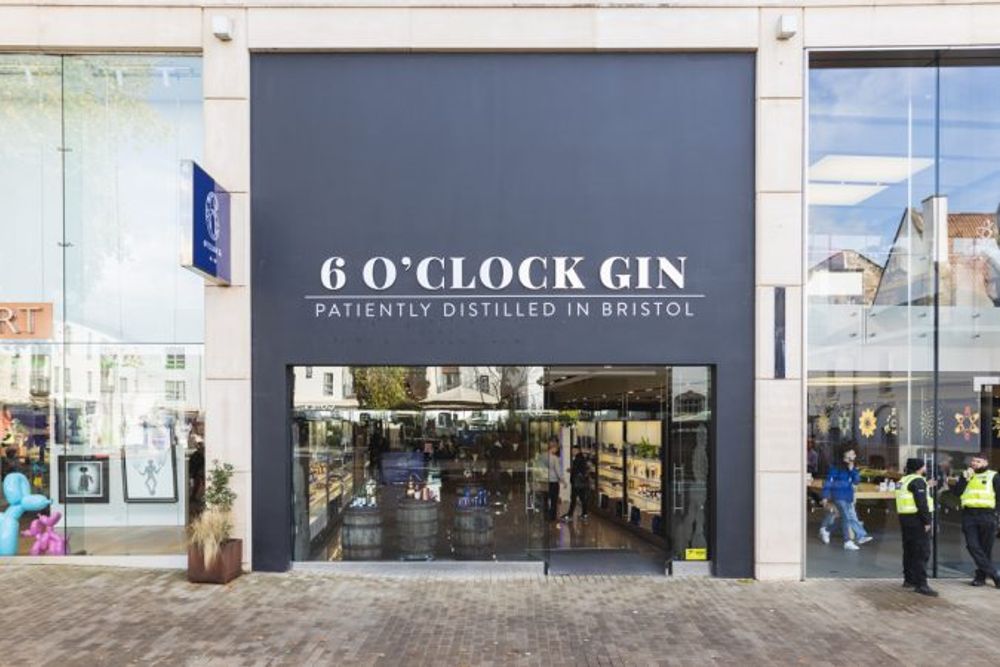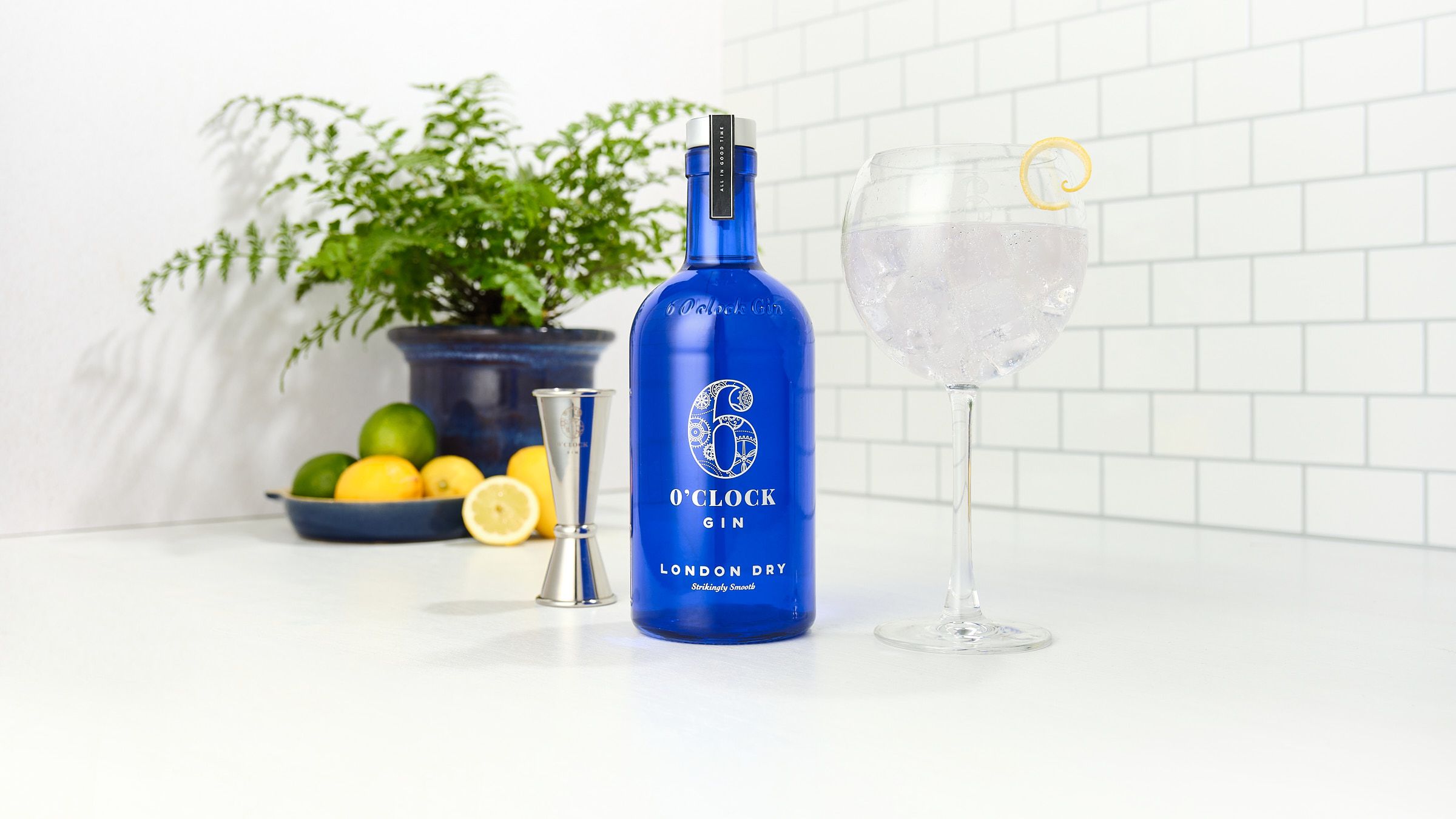With a great name and distinctive bottle 6 O’Clock gin has got a story to tell. Over to managing director, Paul Sullivan…
Tell us about your gin – first of all the name – where does that come from?
6 O’clock gin is named after a Kain family (our founders) event. An ancestor was in the merchant navy and to ward off malaria they were given a daily quinine powder to take. As this person was an officer they were allowed to take it at 6 O’clock with a gin rather than water to soften the bitterness. When home the daily gin routine was continued at 6 O’clock and so when the gin was invented the 6 O’clock gin became the brand.
How did 6 O’Clock gin come about?

Felicity, Michael, Edward and Penny Kain – the family behind 6 O’Clock gin
The business initially created gin to soak sloes and damsons from Edward and Penny Kain’s fruit farm to make Sloe and Damson gin. Michael, Penny and Edward’s son, then decided to create a gin to be enjoyed as a gin and with their knowledge of distilling and passion for gin and after much experimentation and still development our London Dry was born.
How does your gin differ from others in the market?
Our London dry is a strikingly smooth gin. This is a combination of botanicals that give a citrus fresh delicate flavour, a consistent commitment to only taking the true “heart” of the distillation and the unique copper surface area of our still Kathleen.
Who is your target audience?

Six O’Clock gin is looking to widen its appeal amongst younger drinkers, particularly female, by introducing summer serves and taking part in a large number of outdoor events
Premium gin consumers. Skewed slightly to female drinkers and with a core audience 35-54. Our research shows they like podcasts and video on demand as their time is constrained and they like food, travel, eating out and live music.
What is your route to market and key targets customers/ channels?
We have a broad route to market with listings is some supermarkets and our ready to drink can range is about to be rolled out into a number of regional co-ops. We also support independent retailers, farm shops, garden centres and specialists as our London dry is complemented with an export strength gin, sloe, damson and a mango, ginger and lime created in association with chef Romy Gill.
Are you looking to make any changes to your range ahead of the abv-driven duty hike this August?

6 O’Clock gin would not be possible without Kathleen – the copper still that makes it
We’re not looking to make huge changes and will look at the future strength of our new lines as part of the NPD process. However, we operate in the premium gin category and so the important thing is that consumes get quality for their money so fiddling around with the strength of our current range is not our focus.
The important thing to do now is to get drinkers on board with our product so they know that it is worth it and we are doing a lot of sampling prior to the increase.
You’ve recently launched an Indian-inspired gin in collaboration with chef Romy Gill. How did that come about and your target market for that?
Romy had a restaurant local to the distillery and we were also working with Jekka (McVicar) on some exclusive lines. We wanted to do a flavoured gin, but didn’t want something artificial and confected and Tom Fowkes, our marketing director, and Romy worked together on the flavours to get a great balance and something that would work with Romy’s style of food too.
You are looking to create dedicated 6 O’clock gin bars, what are you doing exactly and what do you hope they can achieve?
We have some dedicated branded spaces, much like a number of other drink companies, that allow us and our partners to serve our gins and to increase our awareness. We have bespoke bars and spaces at Tortworth Court, Guildford Pavillion and The Avon Gorge Hotel. They are all great, convivial settings where we can target our core consumer and increase our awareness. A great drink in a great setting can’t be beaten and this provides some seriously positive reinforcement for the brand.
How involved are you in education around gin and the mixers to use?

6 O’Clock gin has worked with Indian chef Romy Gill to create different flavours that are also a nod to its Indian roots
We have a fantastic team at the distillery offering tours and undertaking sampling with customers as well as attending masterclasses at events. We’re very much a flavour first business and ensuring that the product and mixers deliver.
It’s not just gin and tonic, but long drinks and how best to partner so we would suggest Damson along with ginger ale etc. That said, the smoothness of our gin and the intense botanicals generally require a delicate tonic to best bring out the flavours.
You are also involved in a number of festival and sports sponsorships this year – what are you doing?
Probably too much by the looks of our event organiser. We are activating at Ashton Gate for music festivals and the same with CBS arena, we’re also going to be at Shindig and Womad festivals, foodies festivals, gin to my tonic, Gloucestershire Cricket Club matches with more to come. We also have a team in the US and they sponsor the Tampa Bay Lightning Ice Hockey.
You are also launching a new gin bar in Bristol? Why there and what are you doing?

6 O Clock gin has looked to build its connections with Bristol by having a pop up shop and bar in the city
We see Bristol as a key part of our history and whilst we are not geographically anchored by name and so not a regional gin, we play a bit to our Bristol roots with the London Dry being in a version of Bristol Blue glass and our export strength gin being named Brunel after Isambard Kingdom Brunel who built the Clifton Suspension Bridge and we support the SS Great Britain in the Harbour. So Bristol is like a home to us.
We’re not just launching a gin bar we are opening a gin palace. We’re taking on the famous glassboat in the harbour in Bristol and turning it into a shop, gin bar and gin blending and cocktail masterclass experience along with the opportunity to run pop up food events too. A great experience in Bristol, great for gin education and the brand and superb for tourism too!
The gin boom continues – but what do you think the category needs to be doing to keep itself on the front foot and increasing sales?
Gin is evolving again, there’s been a plethora of sweeter, flavoured gins on the market that will target a younger consumer and create an entry platform. As these consumers carry on their gin journey they will move towards drier, more botanically driven gins. The category needs to continue to engage and communicate with trade and consumers and remember that the job is never done.
We spend all day around gin, our consumer spend a lot less time and engage a lot less frequently. The category needs to remain simple, grounded and approachable. Cocktail are great and have their place, gin and tonic is for some, for others long mixed drinks present an opportunity. We need to ensure gin is democratised and we don’t end up speaking to ourselves. If we assume most of our consumers don’t know and don’t care that’s a decent place to start.
What do you see as the key trends within gin and where it now sits versus other major spirits categories?

Striking bottle and design..
Chances are I am wrong as the gin category took a big turn during the pandemic with a real change in consumer consumption which is now starting to even out. Less sweet, subtly coloured gins will come to the fore. As will most categories consumers will drink less better and so higher strength more intense botanicals will increase – if you are going to have a gin, have a good gin.
Over the last 10 years gin has been taken more seriously but has never been a neat spirit alongside white rum and vodka (in the main). I think the sweet gin drinkers may migrate to rum which is a growth category with many nuances, but gin can offer an approachable sophistication for those who do not desire and Whisky/Whiskey. Gin based cocktails will continue to grow as the on trade develops.
What are your key targets for the brand over the next five years?
To increase awareness, in the grand scheme of drinks brands we are still in the discovery stage. We have a distribution support team in the US and have some small export business which we are looking to grow. If we can increase the distribution we have the resources in support with marketing activity, advertising etc down the road.

The brand hopes to grow by offering more opportunities to connect with its customers, be it through distillery tours and direct delivery.
If we start to deliver that then one day a new distillery to further enhance our tours and get the whole business under one roof, which isn’t possible at the moment.
Do you export? if so what trends are you seeing in different markets?
We only do a little export, but we do have a presence in the US, predominantly Florida, but a few other states too. Gin is a very minor category there, but with huge potential for growth. There’s a much more developed cocktail/mixology market and London Dry is a distinct and recognised category in those markets. Not something that is actively mentioned in the UK.
In the European markets we’re seeing UK gin come under pricing pressure from other markets and the “Englishness” is less of a defining USP.
What is your personal background and how did you get into drinks?
I have been steeped in drink all my career from a graduate trainee with Matthew Clark, to working on Lindemans, Penfolds, Kumala, Kendall Jackson and Lyme Bay wines along with 10 Years at Wadworth brewery selling and marketing 6X and the pubs estate.
Back in the dim past I needed a job after a degree in psychology, after numerous applications I was offered two jobs: a psychologist with the Ministry of Defence; or as a graduate trainee in the drinks industry. My father suggested I might have more fun in the drinks industry. I think he was right…
- To find out more about 6 O’Clock gin click here.
































